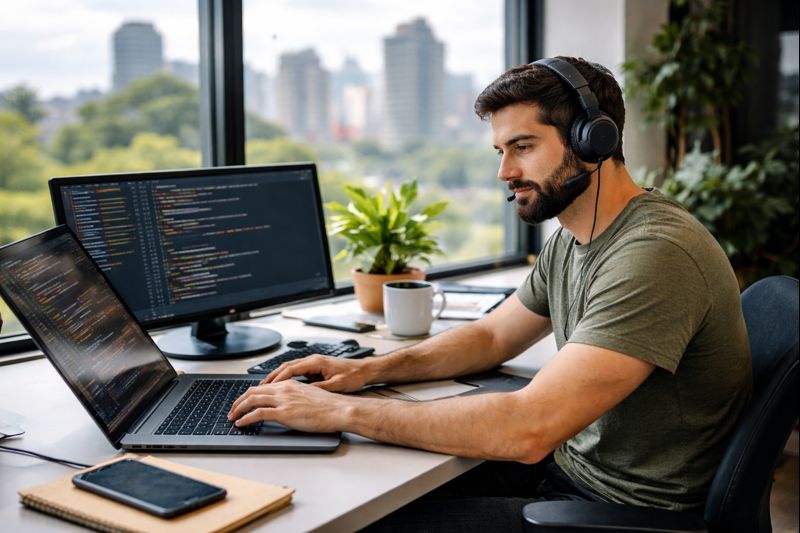Latin America has become a premier destination for nearshore software development, offering a mix of cost efficiency, cultural compatibility, and skilled talent. With minimal time zone differences, companies in the U.S. and Canada are increasingly leveraging LATAM’s growing tech markets for seamless collaboration. The post-Covid-19 era has brought significant trends that require attention, including a more than 200% increase in digital integration among companies in Latin America since 2020. For a company like Teilur Talent, which collaborates with various midsize to Fortune 500 organizations primarily based in North America, this surge in digital integration contributes greatly to its success.
Benefits of Nearshore Software Development: Outsourcing in LATAM
1. Cost efficiency
Hiring software developers in LATAM reduces labor costs compared to the U.S. since the cost of living in the country is less compared to the US, maintaining high-quality output. Countries like Colombia, Mexico, and Argentina offer competitive pricing without sacrificing expertise.
2. Time zone compatibility
LATAM countries share similar working hours with North America, for example for PST time zones Argentina is a good fit, for EST time zone Mexico or Costa Rica are aligned and for CST Colombia aligns perfectly within this time zone, making communication smoother and improving real-time collaboration. This eliminates many of the delays common with offshore teams with time differences of 6 - 8 hours.
3. Cultural alignment
Software developers in LATAM are familiar with U.S. and Canadian business practices and standards due to their proximity to those countries, making onboarding and project management more effective. A shared work ethic fosters long-term partnerships.
4. Access to highly skilled talent
With a growing focus on STEM education and booming tech sectors, countries like Argentina, Colombia, and Costa Rica provide access to developers with expertise in AI, cloud computing, and mobile development.

The best region for nearshore software development outsourcing
Latin America stands out as the top region for nearshore software development due to its cost-effective talent pool, minimal time zone differences, cultural alignment, and growing expertise in emerging technologies like AI, cloud services, and fintech. Countries such as Mexico, Colombia, and Argentina excel in delivering innovative solutions while maintaining smooth collaboration with U.S. and Canadian businesses. Here, we present the number of software developers in the main Latin American Tech Hubs.

A great example of tapping into LATAM talent is Teilur Talent, a partner with a transparent pricing model. Imagine you were to hire a back-end engineer with Teilur Talent. They give you the potential ranges of salary, and once you are ready to make an offer Teilur Talent will give you insights into what is a competitive offer. The best part is that they will tell you how much of that payment they keep and how much goes directly to the developer, and this margin never exceeds 20%. This is one of the most disruptive approaches Teilur Talent implements.
Top Nearshoring Software Development Countries for Talent Outsourcing in LATAM
In this top we ranked the best countries to nearshore software development: Outsourcing in LATAM, for each country we spotlight the best attributes of each country individually, taking into consideration: Time zone alignment, geographical proximity to US and Canada, education and technical expertise and language proficiency.
- Mexico: A dynamic nearshore tech hub.
- Proximity and Collaboration: Mexico offers easy travel access and overlapping time zones with the U.S., facilitating real-time communication and visits.
- Technical Expertise: Software developers specialize in AI, fintech, IoT, and cloud engineering, making Mexico a strong fit for companies focusing on advanced technologies.
- Educational Investment: Mexico graduates around 250,000 ICT professionals annually, ensuring a steady supply of talent to support large-scale projects.
- Argentina: Tech innovation powerhouse.
- Specialized Talent: Known for producing top talent in blockchain, fintech, and AI, Argentina offers innovative solutions tailored to evolving business needs.
- Resilience: Despite economic challenges, Argentina’s tech sector remains strong, with engineers known for problem-solving and creativity.
- Education and English Proficiency: Engineers often have advanced degrees and fluency in English, facilitating seamless collaboration with international teams.
- Colombia: Emerging Talent Market
- Rapid Growth: Colombia is experiencing a surge in IT talent development, offering 150,000+ professionals with expertise in software, mobile, and web development.
- High English Proficiency: Colombian developers are recognized for strong communication skills, ensuring smooth project management and execution.
- Government Support: Initiatives like public-private partnerships foster tech education and create an environment conducive to innovation and tech outsourcing.
- Brazil: Largest Talent Pool in LATAM
- Scale and Versatility: Brazil boasts the largest tech workforce in Latin America with over 750,000 professionals, covering areas like mobile development and DevOps.
- Cloud and AI Expertise: Brazilian developers have deep experience in cloud computing and AI, making them ideal for digital transformation projects.
- Ecosystem and Hubs: Major cities like São Paulo and Rio de Janeiro host tech hubs, accelerators, and events that attract talent and foster innovation.
- Costa Rica: Reliable and specialized tech talent
- Political Stability: Known for its stable business environment, Costa Rica offers long-term reliability for outsourcing partnerships.
- Specialization in Cloud and Cybersecurity: Costa Rica's developers focus on high-demand fields, including cloud infrastructure and cybersecurity.
- English Fluency and Cultural Fit: With excellent English proficiency and cultural alignment, Costa Rican professionals work seamlessly with U.S.-based teams.
Conclusion
The nearshore software development outsourcing strategy in Latin America offers North American companies a strategic advantage by blending proximity to the US and Canada, talent quality and highly skilled talent pool, time zone alignment, and affordability on the collaboration in your business working hours; this will not only represent cost savings in your company, but workload decrease in your in-house software development team.
With LATAM countries strengthening their tech industries, businesses can achieve better scalability, faster delivery, and stronger partnerships. If you’re searching for the right nearshore partner with transparent pricing, try our pricing calculator below, where we disclose our fees upfront, the candidate’s salary, and the total payment, or book a call to find the right talent based on your business's unique needs.
FAQ
1. What is nearshoring?
Nearshore outsourcing is the practice of getting work done or services performed by people in neighboring countries rather than an organization's own country. The most common types of jobs that are outsourced include software development, technical support and call center jobs.
2. What is an example of nearshoring outsourcing?
Another example of nearshore outsourcing is when Toyota Motor hired a third party from a neighboring country. Toyota Motor is a Japanese manufacturer of automotive products, selling cars in various parts of the world. The company engaged a nearshoring provider to build its second production unit in Thailand in 1996.
3. Why is nearshore better than offshore?
Nearshore outsourcing bridges the gap between offshore and onshore, providing the best of both worlds. As the name implies, the organization with which you will collaborate must be located in a country close to yours and, ideally, share the same time zone (or at least, not have more than 3 hours difference between).
4. What is the nearshore software development model?
Nearshore software development is an outsourcing model where a company outsources software development projects to a third-party team in a nearby countries i.e. a country within 1-4 time zones. Usually companies nearshore to locations with large pools of untapped talent exist.








